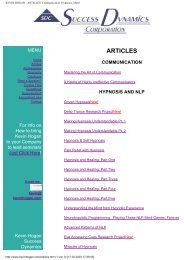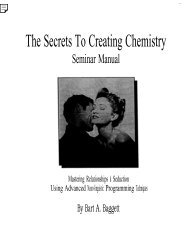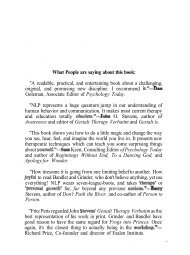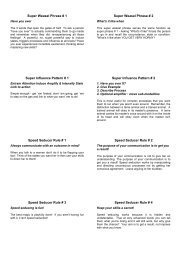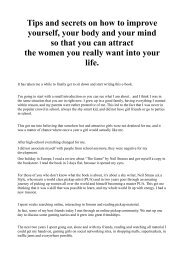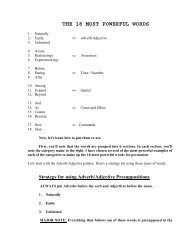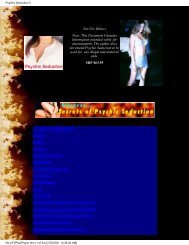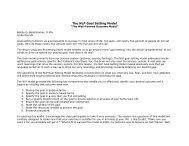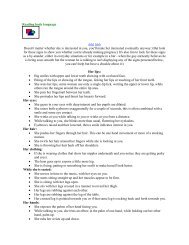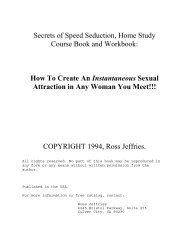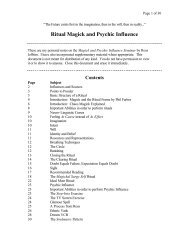A Pragmatic Guide To Communication & Change.pdf - NLP Info Centre
A Pragmatic Guide To Communication & Change.pdf - NLP Info Centre
A Pragmatic Guide To Communication & Change.pdf - NLP Info Centre
- No tags were found...
Create successful ePaper yourself
Turn your PDF publications into a flip-book with our unique Google optimized e-Paper software.
arrives, we may not even like it, though we liked what was represented by the menu.<br />
Ideally, we would be able to go into a restaurant, stop by the kitchen, and sample the food<br />
before we decided. Even then, however, we couldn't be absolutely sure of what we would<br />
get when the waiter brought our food. But at least we might have a better idea.<br />
We cannot actually "sample" reality as the metaphor suggests. All we ever have are<br />
menus: models of reality which we tend to believe are what they merely represent.<br />
For every organism there are, limitations and regularities which define what will be<br />
learned and under what circumstances this learning will occur. (p. 416)<br />
Gregory Bateson<br />
Steps to an Ecology of Mind<br />
The construction of our models of the world is not a haphazard, disorganized process. It<br />
is a highly efficient, ongoing procedure that operates throughout our whole lifetime. The<br />
"information" used in the construction of our models, the experiences and memories of<br />
experiences that form the building blocks of the structure, are forced through certain<br />
constraints or "filters" on the model-building process. There are three constraints or filters<br />
which have been identified by Bundler and Grinder.' These are neurological, social, and<br />
individual constraints. Knowing the ways that these filters affect our models of the world<br />
can assist us in better observing the behavioral patterns that will enable us to both predict<br />
and influence with remarkable success the behavior of our clients, students, and others<br />
with whom we cummunicol,<br />
Neurological Constraints<br />
It is through our neurological makeup, our sense organs and nerves, that we initially<br />
receive information about the world. However, due to individual differences and the fact<br />
that "raw" information is translated into bioelectric impulses, we are inexorably separated<br />
from the "real world." Our neurology filters the experience, and, because everyone's<br />
"filters" are slightly different, we can assume that everyone's model of the world will be<br />
different. This phenomenon underlies the idea that we do not react to the "real world" but<br />
rather on our own personal model of the world.<br />
The Study of Perception<br />
A term common to the study of perception is absolute threshold. This is the minimum<br />
amount of physical energy necessary to stimulate a sense organ into firing off a signal to<br />
the central nervous system (CNS). This means that there are potential sensory signals<br />
from our environment that are never even "received" or sensed. Our sensory organs not<br />
only channel information into our CNS but also effectively<br />
14<br />
In his book Persuasion and Healing, Jerome Frank isolates some of the variables that<br />
make up a successful therapeutic relationship, especially aspects of the relationslip that<br />
result in the patient's "susceptibility to the therapist's influence." (p. 197) Of particular<br />
interest here is the emphasis put on several variables: the client's expectations and his<br />
trust in the therapist, and what he calls "personal attributes of the therapist." Frank found<br />
that these factors greatly influence the outcome of therapy.<br />
A study conducted by Strupp, et al.,s singled out the patient's trust in the therapist as a<br />
singularly important variable. As they stated, "This faith in the integrity of the therapist as<br />
a person may be called the capstone of a successful therapeutic relationship subsuming<br />
other characteristics." (p. 36)



